Why bother with a DSLR? Fuji have decided that it’s easier to stick a huge zoom on a camera and pack it with pixels. Enter the S100fs.
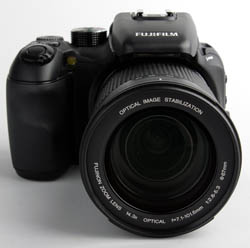 Fujifilm FinePix S100fs: Specification
Fujifilm FinePix S100fs: Specification
- Optical zoom: 14.3x
- Resolution: 11.1Mp
- Sensor type: CCD HR
- Resolution: 3840 x 2880pixels
- Colour: Black
- Focal length: 28-400mm (35mm equiv.)
- Viewfinder type: Electronic
- Movie mode: Yes
- Screen size: 2.5in
- Card format: xD/SD/SDHC
- Battery model: NP-140
- Weight: 918g
- Size: 133.4 x 93.6 x 150.4mm
- Minimum focus distance 1cm
- Screen resolution 200000
- File formats JPEG/RAW
- Connectivity: USB
- Flash type: Built in
- Face detection Technology: Yes
Very few models fall into the same classification as the S100fs. The Leica V-Lux 1 at £590 has a lower 10.1Mp resolution, slightly smaller 12x optical zoom and a slightly smaller 2in screen. However, optical quality outshines with the DC Vario Elmarit lens and of course there’s the prestige of owning one.
Feature wise, you could look at the Canon Powershot G9 at £504 with fully manual controls, hotshoe and slightly higher resolution. The Canon only has a 6x optical zoom though.
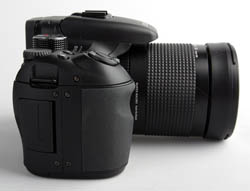 Fujifilm FinePix S100fs: Modes and features
Fujifilm FinePix S100fs: Modes and features
At first glance, the S100fs looks very exciting with small indications of superior specification such as optical image stabiliser on the front of the lens, 1cm macro written on the side of the lens barrel and a flip out screen.
Starting at the front, it’s impossible to miss the 28-400mm f/2.8-5.3 lens with manual zoom and image stabiliser. The AF emitter is tucked away in the corner of the chunky hand grip and even a PC sync socket has joined the party, located at the bottom just under the lens barrel. This port is used for linking the camera to studio lights.
Drooping over the lens like a melted candle is the built-in flash which has its own button to pop it up. The flash is supported by an external non-dedicated hotshoe for attaching an extra flash gun. The top plate houses the large mode dial and thumb wheel which is for making adjustments to levels such as the shutter speed or aperture. ISO and exposure compensation buttons can be found just in front of the thumb wheel with the shutter release surrounded by the power switch, taking prime spot on the grip.
The sides of the camera have plenty to keep you busy, too. The continuous shooting button is located towards the top with the image stabiliser button just below. The focus mode switch is also there and is a small switch that needs to be operated by the thumb. It’s a horrible switch that’s tough to operate and if you haven’t got long fingernails, could really hurt your skin due to the amount of pressure you need to apply. In the switch is a small button that acts as the one-touch AF button.
On the other side is the card bay. The Fujifilm FinePix S100fs is a dual format and takes xD and SD memory cards. xD aren’t the easiest card to get in and out of this camera and they’re capped at a 2Gb maximum storage capacity. SD are available up to 8Gb and my Lexar 4Gb card went in with no problems.
If that wasn’t enough for you, the back of the camera has even more features to immerse yourself in.
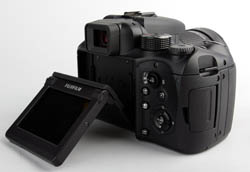 The back of the S100fs sports six buttons, one being Auto Exposure lock which also has one of those tough switches for metering modes. The other buttons are for switching between the electronic viewfinder (EVF) and the screen, accessing playback, face detection functions and display options for scrolling through the on screen information being on, off or joined by the rule of thirds grid.
The back of the S100fs sports six buttons, one being Auto Exposure lock which also has one of those tough switches for metering modes. The other buttons are for switching between the electronic viewfinder (EVF) and the screen, accessing playback, face detection functions and display options for scrolling through the on screen information being on, off or joined by the rule of thirds grid.
The sixth button is to access the menu and the navigation pad sits around it. This pad is for working your way through the menus and it also doubles up for quick access to macro, self timer and flash functions with the fourth button being employed as a zoom to check quality. This is for users that like to manually focus and pressing the button will zoom into a portion of the image so you can check that focus is sharp before shooting.
Scrolling through the options on the mode dial and a mock display of the dial will animate on the edge of the screen to save you having to look at the real one.
As well as Auto, two scene modes and PASM options, the mode dial also has two custom function settings, a video mode and an option called FSB.
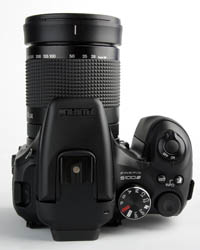 The FS in the title of the camera stands for Film Simulation, but it’s by no means a new feature from Fuji. They’ve been adding different film simulators in their cameras as far back as the S5000 5 years ago. The options in this menu are different however. Four different film types are available and they are Provia, Velvia, Soft and Portrait. Each setting gives a brief description of what it does and the type of photography it’s best suited to.
The FS in the title of the camera stands for Film Simulation, but it’s by no means a new feature from Fuji. They’ve been adding different film simulators in their cameras as far back as the S5000 5 years ago. The options in this menu are different however. Four different film types are available and they are Provia, Velvia, Soft and Portrait. Each setting gives a brief description of what it does and the type of photography it’s best suited to.
Alongside the film options is a small chart that shows the settings to the D-Range, Colour, Tone and Sensitivity.
The Fujifilm FinePix S100fs has three Dynamic range optimisers. According to the Fuji website, the settings available of to 100%, 200% and 400% mean that the dynamic range is getting close to negative film. It increases the range of whites to blacks available on the image, showing more detail.
The EVF still makes everything look like you’re using a camcorder and I doubt that will ever change. The white balance tends to adjust itself continuously and comes into the correct cast when the shutter release is pressed half way down for focusing. It doesn’t suffer from motion blur, which is great, and the purple banding sometimes found under and over windows is only present for a split second.
The Exposure Compensation button is manipulated using the thumb wheel just behind it. Despite the convenience of close locations, both hands are needed to use it. During operation, a histogram comes up to show how under or over-exposed the shot is, backed up by the image darkening or brightening in the screen.
If all this wasn’t enough for you, the drive mode has seven separate options including Dynamic Range Bracketing, Film Simulation Bracketing, AE Bracketing and top or last seven continuous shooting. They’re on top of long period and top 50 (only shoots at 3Mp). Interestingly, switching the camera off during download does nothing. The camera will complete its action before switching off which is a great safety precaution.
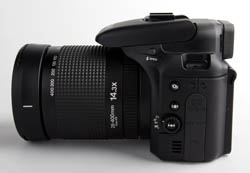 Fujifilm FinePix S100fs: Build and handling
Fujifilm FinePix S100fs: Build and handling
The plastic exterior feels very tough and there isn’t a part on the camera that feels badly made. Fuji is one of a selected few brands that I grew up with, so I know what they’re capable of as my first SLR was a Fujica ST-800. The battery bay has a little play, but the movement feels steady as though it’s purposeful.
Looking at the lens barrel it seems heavy and stiff but I’m surprised to feel a smooth, free play to it. Looking through the viewfinder as I move the zoom from wide angle to its full telephoto, the focus can’t cope with the swiftness of the zoom and it does get thrown out of focus for a few seconds.
Because the thumbwheel, zoom and buttons are so well put together, I’m still really amazed to see the smaller switches that are used to adjust the focus and metering modes. They are tough to move and using your thumb and knuckle of your forefinger (I found this the most convenient), your skin will be torn to shreds in a matter of days.
The 2.5in screen flips out to a 90 degree angle and has a second hinged plate sat directly behind so the screen can extend to the angle pointing up or down to 45 degrees. To pull the screen out, you have to get your finger under the bottom and flip it out that way. I discovered that this wasn’t the easiest thing to do when the camera is sat on a tripod.
However it’s a sturdy screen with positive movement, not just some whimsical affair that was stuck on when the designers thought it would be a good idea.
Fujifilm FinePix S100fs: Flash options
As mentioned in the tour of the camera, a built-in flash is situated crouching over the lens barrel. This is activated by pressing the button on the left of the camera and the flash will pop into action. It’s a mechanical trigger as the flash will spring up whether the camera is switched on or not.
Activating the flash means it will switch on in auto mode. Flash on and Slow sync are also available. Red-eye removal is found in with the face detection button on the back of the camera. This feature is software based, so the S100fs doesn’t have a red-eye reduction feature.
The hotshoe is non-dedicated, so even dedicated flash will fire from the camera. Bear in mind that any dedicated flash units won’t be able to use their dedication features. Flash units must be adjusted manually.
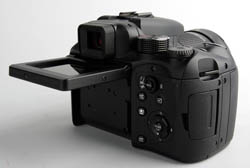 Fujifilm FinePix S100fs: Performance
Fujifilm FinePix S100fs: Performance
The colours on the landscape mode blow me away. The grass is a lush, rich green and there’s good detail, but the fringing is horrible. Bright purple banding on the white bars at the edge of the lock and also on the windows of the building. Moving to the roof of the building, which is a typical place to find fringing, and a green stripe runs along its edge.
I’m disappointed with this result from a camera that is otherwise turning out to be quite sterling.
The colour chart has given good results. The primaries aren’t as vibrant as I’m used to, but are still boosted. The tones are evenly balanced with the white coming out brilliantly. The skin tone colour is a little on the pale side, but may improve if the film simulation was changed to portrait.
I shot the same scene in three of the four different film simulations: Provia provides good detail and a balanced yellow of the rape seed flowers, while Velvia gives the shot a more greenish cast on the flowers. The Soft film mutes the colours slightly. This is a change from Fuji’s previous film settings. Older cameras had Colour film, Slide film, Sepia and Black & white. These were simple, but had a noticeable change in the image. The Slide mode, for instance, would cool the image down slightly just like Fujichrome.
The Fujifilm FinePix S100fs has two macro modes. the closest having the capability of getting in as close as 1cm.
This is a great feature, but the lens is so huge, that getting so close in means light can’t get through and a longer exposure is needed. With that in mind, a tripod is necessary for this mode as the shot I took of the peacock feather is just over three seconds long. The problem is that because some light was getting in at the top left corner, the long exposure has over exposed that area.
Three portrait modes are available, excluding the baby portrait mode, designed to give more freedom to your work with as little effort as possible.
Fujifilm FinePix S100fs: Noise test
The ISO has two separate areas which deal with the true ISO at 11Mp and an equivalent which has to drop the resolution.
The true ISO ratings give excellent results. Noise only starts to sharpen at ISO1600, but at ISO3200 the quality really starts to drop off and detail is lost in the petals.
In the equivalent modes, ISO1000 drops the resolution to just over 3Mp which will automatically degrade the image anyway compared to the full size resolution. ISO6400 drops the resolution to 6Mp and detail in the petals is barely noticeable with purple splodges on the grey card.
Fujifilm FinePix S100fs: Verdict I like the different film simulations available and the handy chart showing the Dynamic Range, Colour, Tone and Sensitivity. These features are extremely useful for photographers of all skill levels to broaden the creativity.
I like the different film simulations available and the handy chart showing the Dynamic Range, Colour, Tone and Sensitivity. These features are extremely useful for photographers of all skill levels to broaden the creativity.
Fuji have picked up on the fact that people still like film and have put a lot of effort into recreating realistic film effects for the S100fs using their Film Simulation mode. Photographers still using film because they don’t like the processed colours of digital or those, like me, who have a nostalgic affection for film, will find this feature highly beneficial and great fun to use.
One question I have is: Does this mean that Fuji will end film production? We’ll have to wait and see.
If you’re a film photographer thinking of breaking into digital or a digital user wanting a film camera as back up just to achieve the tones and saturation that make films such as Velvia a photographer’s favourite, be sure you take a look at the S100fs.
Fujifilm FinePix S100fs: Plus points![]() Loads of features to keep you busy
Loads of features to keep you busy![]() Good colour reproduction
Good colour reproduction![]() Great noise results
Great noise results![]() Flip out screen
Flip out screen![]() Super close macro
Super close macro![]() Different film recreations
Different film recreations![]() Huge zoom
Huge zoom![]() PC sync for studio lights
PC sync for studio lights
Fujifilm FinePix S100fs: Minus points
![]() Large camera
Large camera![]() Chromatic aberration present
Chromatic aberration present![]() Sharp switches on metering and focus modes
Sharp switches on metering and focus modes
 FEATURES
FEATURES![]()
HANDLING![]()
PERFORMANCE![]()
OVERALL![]()
The Fujifilm FinePix S100fs costs £412 and is available from the ePHOTOzine shop here.